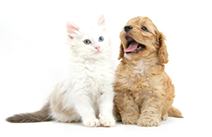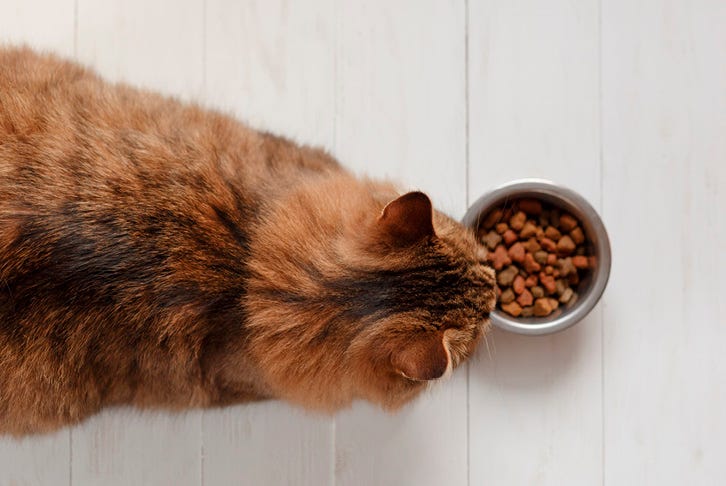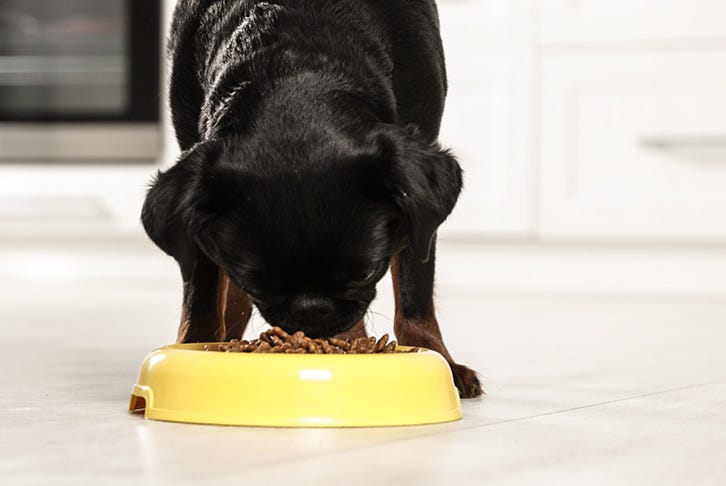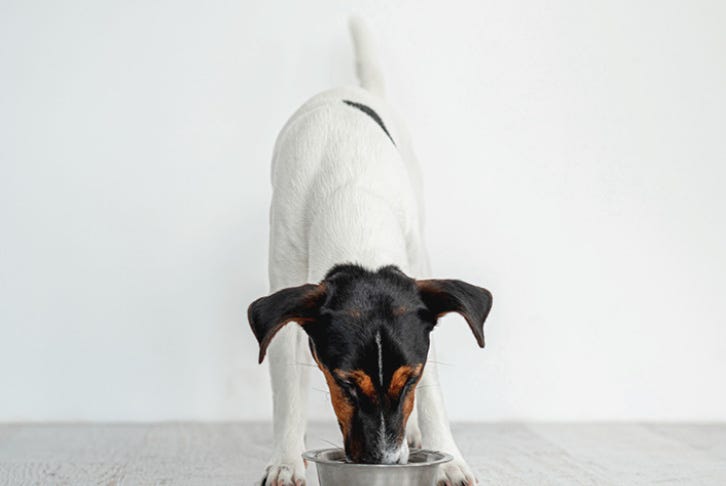What is your pet's skin and coat telling you?
Skin is your pet’s largest organ, and also has an important role in their physical well-being. A healthy coat provides protection from weather conditions, sensory data and even manufactures vital nutrients such as Vitamin D.
The condition of your pet’s skin and their coat is a good indicator of their overall health. Healthy skin should be soft, smooth and clear free of lumps, flakes and raw red spots. Likewise, a healthy coat is a good indicator of health. The coat will be shiny not greasy, smooth not matted, coarse or brittle and will not have an excessive amount of loose hair or bald patches.
Essentially, a healthy diet equals a healthy coat. A nutritious, balanced diet with adequate quantities of protein and amino acid will help to provide strength to your pet’s fur as it is mainly made up of protein. Omega-6 fatty acids will help to add shine to their coat while Omega-3 fatty acids will nurture your pet’s skin reducing sensitivity, inflammation and dry skin. Most Superior Nutrition diets will include these fatty acids along with a range of other nutrients such as zinc, vitamins A, E and B-complex all of which will promote skin and coat health.
Superior Nutrition, parasite prevention and a tailored grooming routine suitable for their skin and coat type are vital for keeping their skin and coat in great condition.
Sensitive skin
As with humans pets can suffer from sensitive skin, allergies and skin irritations can develop due to diet or environmental factors including plants and pollens, fleas, shampoos and food. Often a veterinary check will be required to will need to diagnose the cause of a skin irritation after which your veterinarian may suggest a change in diet. If you are concerned about your pet’s skin book in an appointment with your local Animates Vetcare team.
7 signs of skin irritation
- Raw or red skin
- Dry flaky skin or oily and greasy
- Lumps or bumps on skin
- Strong odours, musky, sour, foul
- Dull, dry, brittle, limp or coarse coat
- Matted or tangled fur
- Hair loss or thinning hair
Pet allergies
Your pet's skin helps to provide protection, regulate their body temperature, prevent dehydration and create vital nutrients.
The function of your pet’s immune system is influenced by both genetics and their environmental factors; some breeds are prone to suffer from allergies others are more likely to develop allergic reactions over time.
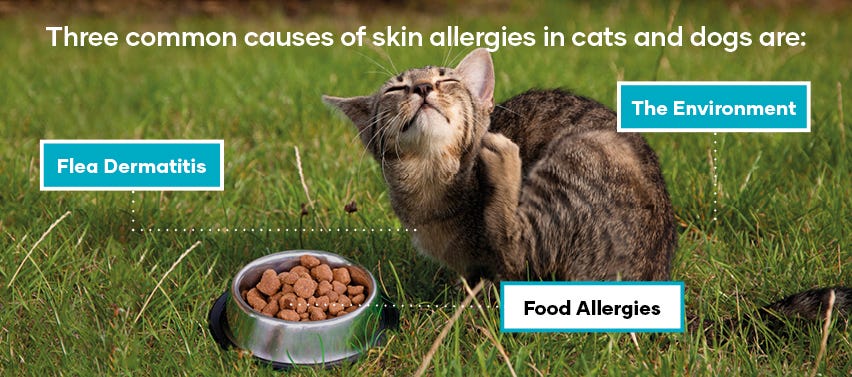
Allergies can be difficult to diagnose with symptoms varying greatly. If you notice your pet scratching or licking excessively, thinning hair, bald patches, red skin or have any concerns, see your veterinarian for advice.
- Flea Allergies are the most common allergy and are caused by sensitivity to the proteins in the saliva of a flea rather than a flea bite itself. Flea saliva has five known allergens which can trigger an allergic reaction with just one bite. There is no pre disposition in breeds or the gender of the pet; however, pets under one are less likely to be affected by these allergens
- Environmental Allergies can be caused by the pet inhaling or coming into contact with moulds, dust mites, dust, trees, grass, weeds, pollens, cigarette smoke, fabrics (wood or nylon), rubber and plastic materials, cleaning products and chemicals.
Symptoms include chewing their feet, constant licking of their sides or groin area, rubbing of their face or shaking of their heads, ear inflammation or infections, hot spots or facial scabbing (cats), red itching lumps or blisters usually on the stomach feet or muzzle, hair loss, extreme scratching and in some cases wheezing
- Food Allergies are rare and have a range of symptoms including both skin and gastrointestinal problems
Limiting exposure to allergens
- Ensure that their environment is smoke free and reduce the amount of dust in the house by vacuuming carpets, under bed and near windows. Kill dust mites by freezing plush toys.
- Regularly wash bedding in hot water. Change your cleaning products to non toxic natural products to limit your pet’s exposure to toxins.
- Filter their drinking water or use a pet water fountain if you do not have a water filter available
- Always follow directions when medicating or giving your pet a treatment as their immune system can become over sensitive if medicated too often. Never use human medications, creams, shampoos, or soaps on your pet without first consulting your veterinarian.
- Wash your pet’s feet; their feet will pick up pollen, weeds, moulds and other allergens. Keep your pet indoors when the grass is being mowed and keep them out of fields with long grass. If your pet suffers from allergies, rinsing them off after a walk will remove the allergens from their body.
If you are concerned about your pet’s health and skin, please contact your local veterinarian to find the best option for your pet.
Tips for caring for your pet’s coat
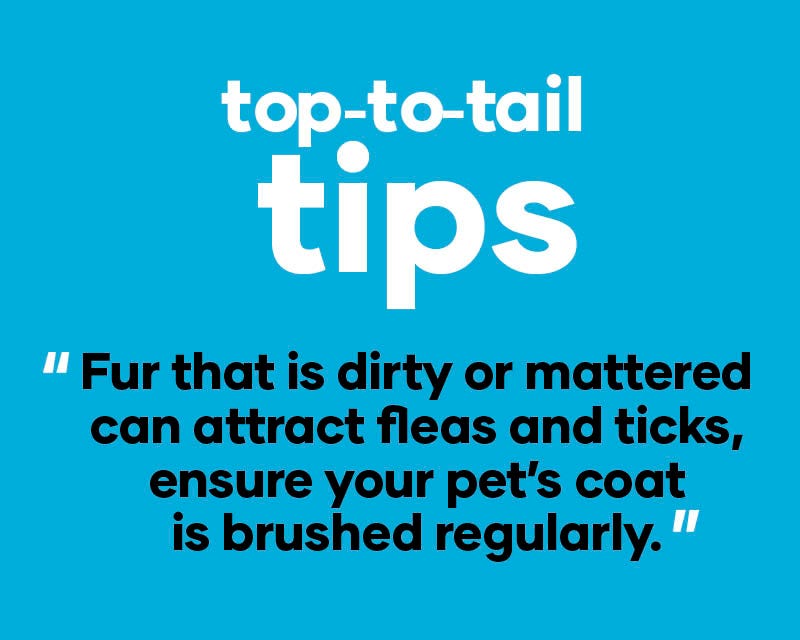
Brushing - All pets will benefit from regular grooming sessions which should be done at a minimum of once a week. It is important that you use the correct tools for your pet’s coat type. We recommend using a brush with widely spaced teeth for the outer layer and a finer soft-bristle brush or comb to maintain their inner layer of fur and the fur around their face. Using a slicker brush is a great way to finish grooming as it will smooth down the top layer of the coat.
Bathing- How often your pet will need to be bathed will depend on their lifestyle, age and coat type however, the average dog will only need to be bathed every 4-6 weeks when they become dirty. Cats will only require bathing when their coat is extra greasy or dirty with grime or a sticky substance which will be hard for your cat to groom off themselves. It is important that you are not bathing your pet too regularly as it will strip their skin of their natural oils which condition the hair.
Only use a pet specific shampoo as the chemicals in human shampoo are too harsh and will wash off their natural oils and wax leaving their coat brittle and dull, potentially causing rashes on their skin.
When looking for a shampoo it is important to avoid artificial fragrances and dyes and stick to natural ingredients such as oatmeal, aloe vera, herbal proteins, vitamins and citrus extracts which are soothing. Use a conditioner to keep their skin and coat moisturised and reduce dandruff.
Nutrition - A balanced diet with adequate quantities of protein and amino acid will help to provide strength to your pet’s fur as it is mainly made up of protein. Dull, fragile hair which shreds excessively can be an indication that your pet isn’t getting the minerals and vitamins which they require from their diet; ensure that the first ingredient on the list of their food is a real source of highly digestible protein.
Other supplements - Omega-3 fatty acids which are found in flaxseed and fish oil are known to reduce itching and inflammation in skin as well as adding shine to a pet’s coat. Zinc and vitamin A can help pet’s that have dry scaly skin or crusting however it is important to always get your vet’s recommendation on supplements suitable for your pet as excessive amounts can cause upset stomachs and vomiting or cause harm if given for long periods of time.
Parasite control - Keeping your pet’s flea and parasite treatments up-to-date is vital to their health. Fur attracts ticks especially in fur which is dirty or matted, the presence of parasites can lead to itchiness and discomfort for your pet, allergic reactions and infections.
If you see any of these symptoms, it’s time to visit your local Animates Vetcare for a skin and coat health check:
- A significant change in your dog’s coat or skin
- Evidence of parasites
- Open sores or signs of infection
Caring for your dog's coat
| Coat Type | Characteristic | Brushing | Combing | Bathing | Other |
|---|---|---|---|---|---|
| Smooth
Greyhounds, Pointers, Bulldogs, Chihuahuas, Boxers
|
Very short hair which is flat to the skin Smooth and shiny with no texture |
Occasional brushing required, usually when shedding Use a dual brush - the bristle side |
Occasional use of curry comb or rubber mitt brush will help to remove dust and add shine |
Use a de-shedding shampoo to help loosen dead hair Use a shiny coat shampoo to keep the coat in good condition Conditioner will help to add shine to the coat A scrubber is recommended to give a deep clean |
|
| Short Pug, Beagle, Labrador 
|
Hair is still short 1-3cm, however, it is less flat than the smooth coat. There will be more texture than a smooth coat Provides more protection against the elements as there are two layers which will make the coat quite dense |
Occasional grooming required with a firm slicker brush | Occasional use of a curry comb or rubber mitt brush to help remove dust and add shine | Fur will hold more water and scent than a smooth coat which means they will require more frequent bathing | |
| Long Pomeranian, Chow, Old English Sheep Dogs, Shitzus, Maltese, Afghan hounds |
Require a lot of maintenance | Daily brushing wih a firm Slicker brush |
Finishing comb, rake / shedding comb Daily brusing with a finishing comb, rake or shedding comb |
Use a shampoo which is specific to long hair. Use conditioner that will protect the coat during grooming, add shine and strength Anti-static grooming spray is recommended to protect the coat A daily conditioning spray is great for reducing matting and adding condition to the coat |
Ear cleaning may be needed please talk to your vet |
|
Curly / Wool Poodle, Bichon Frise, Cocker Spaniel |
Thick and curly with a lot of volume. This is the hardest coat type to maintain with quick and continuous growth Mats easily form |
Daily brushing with a curved slicker brush or pin brush Use a pat and pull action |
Daily brushing with a finishing comb to take out tangles Dematting tools to be used as needed (such as a furminator) |
Use a shampoo which does not have added conditioners Use a coat specific or light conditioner A dematting spray is necessary to maintain a healthy coat and prevent mats, one which is |
Ear plucking and cleaning is often required for breeds with these coats |
|
Wire Schnauzer, Wire Haired terrier |
Requires a specific professional grooming technique called hand stripping Has predetermined length hair will grow to before shedding begins |
Regular brushing with a slicker brush |
Regular brushing with a finishing comb to take out tangles |
|
Clipping is not recommended. If the coat is clipped it will be near impossible to get the texture back and would be very painful for the dog to start hand stripping |
Caring for your cat's coat
| Coat Type | Characteristic | Brushing | Combing | Bathing | Other |
|---|---|---|---|---|---|
|
Short hair 
|
Constant shedding (more than longhaired cats) Will rarely suffer from matted fur or tangles Less tolerant of colder weather |
Brush weekly with a slicker brush
|
Occasional use of curry comb or rubber mitt brush will help to remove dust and add shine |
Rarely needed unless they have allergies or are very dirty with grease or a sticky substance |
|
|
Medium hair 
|
More tolerant of varying temperatures |
Regular brushing every 2 - 3 days as they are more prone to mats and tangles than short haired cats | Comb regularly with a shedding comb (such as furminator) especially coming into summer | Bath occasionally if there is a build up of grease or they are very dirty. This bath will help to keep their top coat conditioned | |
|
Long Hair 
|
Noticeable shedding due to the length of hair; they do not shed more than short haired cats. Prone to hair balls due to the length of their hair creating balls in their stomach
|
Brush daily to prevent tangles and mats which will easily form in their fur |
Comb daily with a shedding comb (such as furminator) |
Bath occasionally to prevent a build up of grease and to condition their coat |
Shaving may be required in hotter temperatures |
|
Rex Cats
|
Curly or wavy fur More likely to mat or tangle Hypoallergenic - as they produce little amounts of dander which causes allergies |
Brush daily to prevent tangles and mats which will easily form in their fur |
Comb daily with a shedding comb (such as furminator) |
Bath occasionally to prevent a build up of grease and to condition their coat |
|
|
Hair less
|
Short, peach coloured "fuzz" Hypoallergenic however those with allergies to the skin oil of a cat will still have a reaction |
|
|
Bath regularly as body oil builds up Prone to having a build up of ear wax due to their lack of long hairs in their ears |
Should be kept indoors as they will be prone to suffering from sunburn and the cold |


